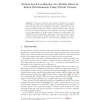Free Online Productivity Tools
i2Speak
i2Symbol
i2OCR
iTex2Img
iWeb2Print
iWeb2Shot
i2Type
iPdf2Split
iPdf2Merge
i2Bopomofo
i2Arabic
i2Style
i2Image
i2PDF
iLatex2Rtf
Sci2ools
126
click to vote
CIARP
2007
Springer
2007
Springer
Robust Local Localization of a Mobile Robot in Indoor Environments Using Virtual Corners
This paper deals with the problem of finding the movement of a mobile robot given two consecutive laser scans. The proposed method extracts a line map from the sequence of points in each laser scan, using a probabilistic approach, and then computes virtual corners between two lines in the same line map. The movement of the robot is estimated from correspondences of virtual corners between the two line maps. The combination of the probabilistic approach to find lines and the reduced number of virtual corners are the key ideas to get a simple, fast, robust to outliers, and reliable method to solve the local localization problem.
Related Content
| Added | 18 Oct 2010 |
| Updated | 18 Oct 2010 |
| Type | Conference |
| Year | 2007 |
| Where | CIARP |
| Authors | Carlos Lara, Leonardo Romero |
Comments (0)

